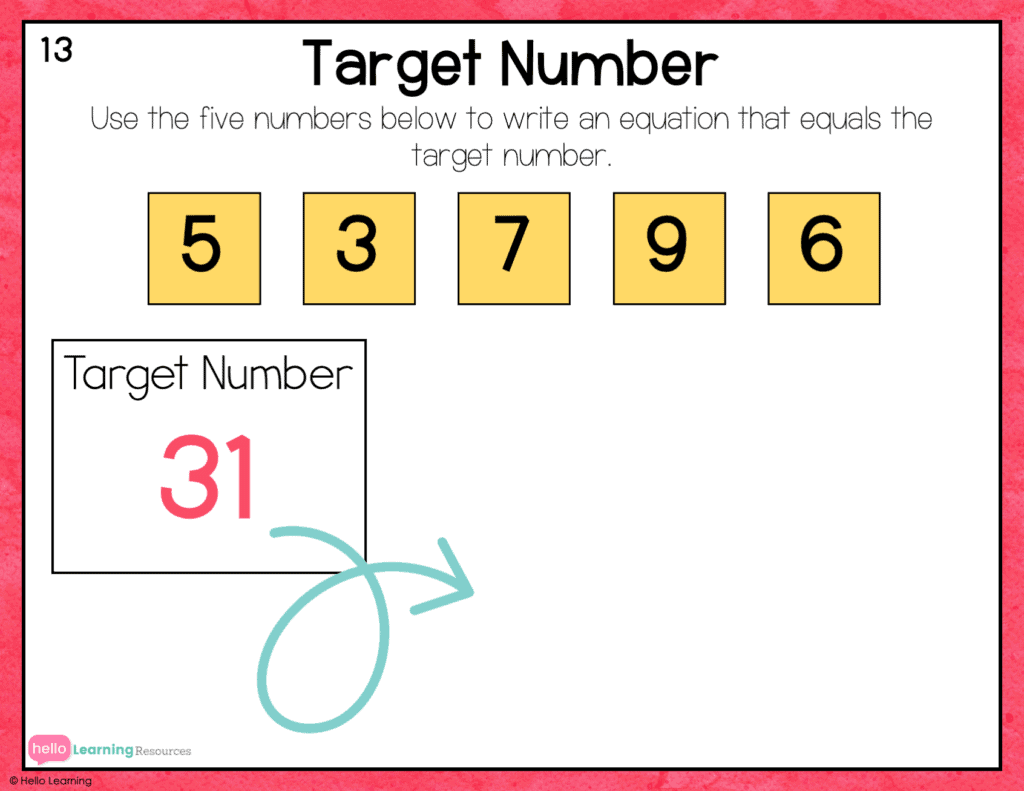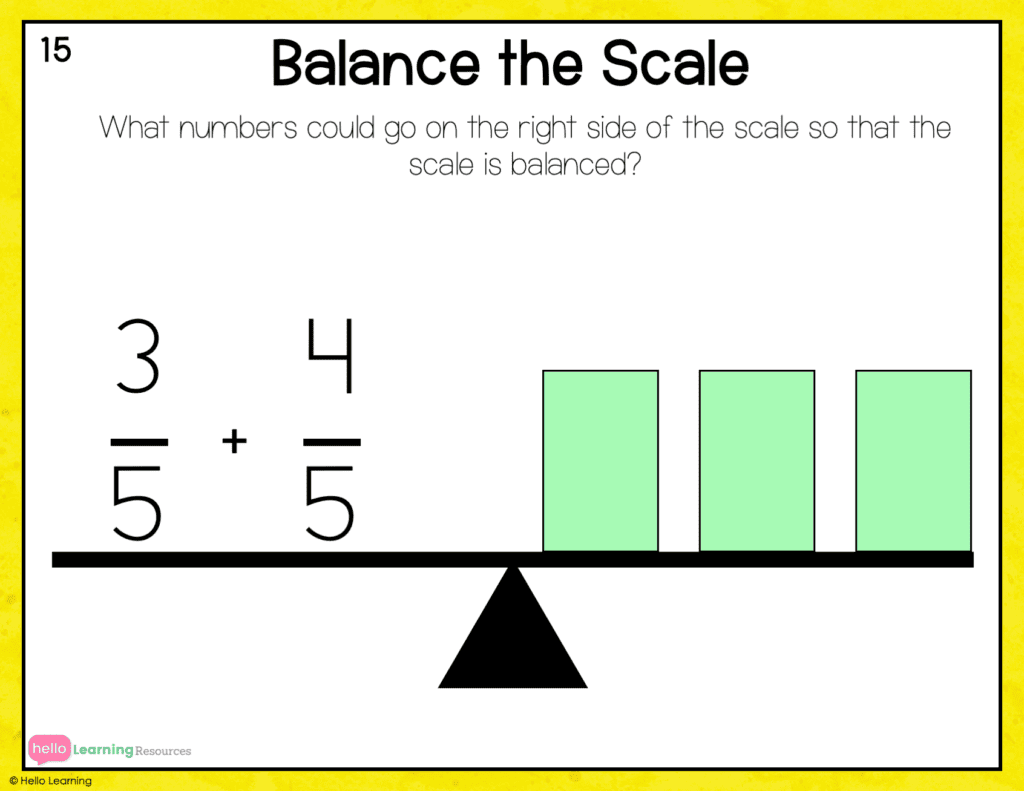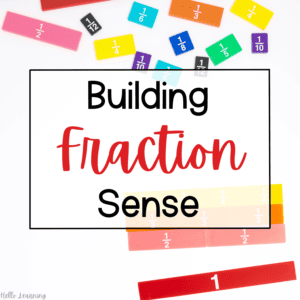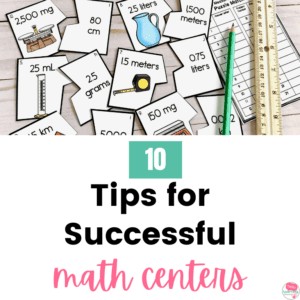Number Talk Examples for Upper Elementary
Are you looking for some number talk examples to use with your upper elementary students?
Number talks are so beneficial to students. They help strengthen number sense, flexibility with numbers, efficiency with procedures and effectively communicating your thinking with others.
Here are 10 number talk examples that you can use with your upper elementary math class, and a freebie just for you at the end!
Dot Talk – Dot Images
The first number talk example you can use is dot talks or dot images.
With dot images, students need to figure out how many dots are shown on a card or slide.
This type of number talk helps to build spatial skills and subitizing skills.

The dots shown on an image can be arranged in familiar patterns or scattered randomly around the page.
Show the image quickly to students (5-10 seconds) and then remove the image. Ask students how many dots there were. You quickly can show the image a second time to have students verify their answer.
After students share how many dots there are, let them know the correct answer.
Although there is only one correct answer for the number of dots on the image, there are multiple ways to get to the answer. Encourage students to share a variety of ways that the dots could be visualized and grouped to efficiently count the total.
Number Lines
Number lines are another great number talk example that can be used at multiple skill levels. Here are a few ideas:

- Show an open number line with benchmarks at both ends. Ask students where a specific number would best fit on the number line and why.
- Display a number line with marked and labeled intervals, but leave a few numbers out. Students will need to figure out what numbers go in the empty places.
- A number line with all of the intervals marked and labeled, but one (or more) of the numbers is covered up. Students need to use the given information to figure out what the missing numbers are.
All of these number talk examples using a number line can be used with whole numbers, fractions, and decimals. You could even try using two (or three) types of numbers within one number line talk.
Which One Doesn’t Belong?

During this number talk example, students are shown a variety of numbers, images, equations, or statements. They have to figure out which one doesn’t belong with the others.
This type of number talk helps students analyze information and draw conclusions.
The great thing is that there can be multiple correct answers, as long as students can explain and justify their thinking about why it is different from the others.
Which one doesn’t belong number talks help students see that math problems can be viewed in different ways and that sometimes it is possible to have different answers.
Would You Rather?
In this type of number talk, you give students two options to choose from. They have to decide which one they would rather have.
This is a great number talk structure for working on unit price but can be used in many other ways.
Some would you rather number talk examples might include:

- Would you rather have one pound of nickels or one pound of dimes? Why?
- Would you rather have 3 bags of candy with 36 pieces each or 5 bags of candy with 23 pieces each? Why?
- Would you rather buy a box of 6 donuts for $4.50 or one dozen donuts for $8.64? Why?
- Would you rather have 3 $1.00 bills or 18 dimes? Why?
- Would you rather have a pool that is 18 feet long and 9 feet wide or a pool that is 15 feet long and 11 feet wide? Why?
Number Strings

A number string is a series of related problems that guide students to learn and use a specific strategy and highlight number relationships.
This type of number talk helps students find efficient strategies to solve problems.
In a number string, problems are sequenced in a way that leads students to see patterns and connections between the string of problems. All of the problems in a number string progress with a focus on a specific strategy.
Target Number
When doing a target number talk, students are given a “target number”. They need to create an equation that is equivalent to the target number.

This number talk example can be done in two ways:
- Open ended: students are given a target number, and they can use any combination of numbers and operations they choose to create an equation equal to the target number. Their equation can be as long, or as short, as they want.
- Specified numbers: students are given a target number and 5 number that they can use in their equation. They can use 2 numbers, 3 numbers, 4 numbers or 5 numbers to create their equation. You can choose any number for the target number, but I only use the digits 1-9 for the five numbers they have to work with. This type of target number talk is more challenging, but it also gives an entry point for all students while providing an extra challenge for the kids who are ready for it or want it.
Balance Scales
This number talk example highlights the fact that the equals sign means equivalent and balanced, not just “the answer”.
In this number talk, students are given a scale with a quantity or equation given on one side of the scale.
They have to balance the scale by creating a number, equation, or collection of values for the other side of the scale that is equivalent.

This type of number talk can be used at many levels. You can use whole numbers, decimals, or fractions. (or a combination of them). One side of the balance scale might have one number, or it might have a combination of numbers or an equation.
The side the students need to balance/solve for might be empty or open-ended, or it might have part of the equation already given.
Number Bonds
Number bonds help students see the relationship between addition and subtraction. Number bonds also help students break numbers apart in different ways and see the relationships between numbers.
Number bonds are frequently used in the primary grades, and with whole numbers, but they also have great applications in the upper grades!

Try using number bonds with fractions or decimals. You can even work with number bonds that have three (or more) parts, or that break numbers down into several layers.
When students work with number bonds they strengthen their ability to break apart numbers, which helps with mental math and computation skills.
Ten Frame
The ten frame number talk example might seem like it only applies to primary classrooms. But did you know ten frames can also help support fractions, decimals, multiplication, and more?

Instead of putting one dot/image in each box of a ten frame, try putting a group of items, like a group of 4 dots. Now students need to look at the ten frame as ___ groups of 4.
Use a fraction in each box of a ten frame. An example could use the number 1/4 or a visual showing 1/4 in each box. Now students need to think of the ten frame as ___ groups of 1/4, or 1/4 __ times.
Fraction Blocks
This type of number talk helps students visualize fractions as a part of a whole, and compare fractional parts of a whole.
I like to use squares or rectangles that are colored using 2 or more colors for these number talks.
Use each color to split the shape into different fractional amounts. Students will need to determine what fraction of the whole each color represents.
You can ask many types of questions all relating to one image. Look at the image below and some of the possible questions that could go with it.

- What fraction of the square is covered by each color?
- What fraction of the square is blue?
- What fraction of the square is green?
- Is the fraction of the square that is yellow greater than or less than the fraction of the square that is blue?
- How many times greater is the blue part of the square than the green part?
- How many times less is the green part of the square than the yellow part of the square?
- Which color covers 6/16 of the square?
- The red and yellow parts of the square combined equal ____ of the square.
The shapes you use can be divided in many ways to increase or decrease the difficulty.
The websites fractiontalks.com and mathforlove.com have a lot of wonderful examples that can be used for this type of number talk.
Now that you have learned about ten different number talk examples, which one will you be trying first?
FREE Number Talk Resource
If you liked the images in this post, then you will LOVE this free set of 20 number talks!
This FREE set of 20 number talks includes all of the number talk examples shown in this post, plus 10 additional number talks. That is enough number talks for 4 weeks of math class!
CLICK HERE or on the image below to grab your free set of number strings to use with your class!
Looking for Some Ready to Go Number Talks?
If you want to get started with number talks right away, and would like some ready-to-go number talk resources, check out my Teachers Pay Teachers store!
CLICK HERE or on the image below to see all of the number talks resources I have created.
Read More About Number Talks
How to do a Number Talk Step by Step
Ways to Encourage Math Talk and Discussion
Pin It!











One Comment